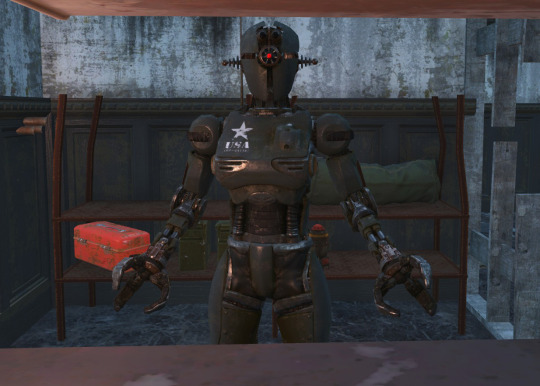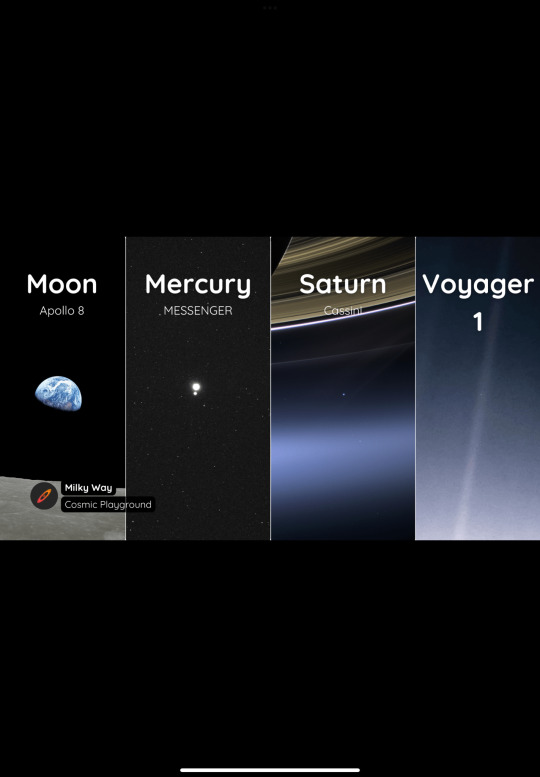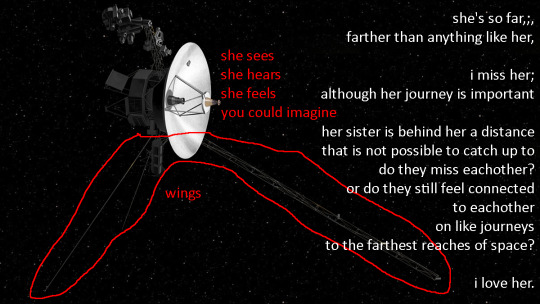#Voyager spacecraft
Text
Voyager 1 Approaches Jupiter (1979)

This gif records the Voyager 1 spacecraft's Jupiter approach from January to February, 1979.
Notice the difference in speed and direction of the various atmospheric zones and bands. Their interaction creates vast storms in the dynamic Jovian atmosphere.
NASA created this time-lapse sequence from 66 images, each taken once per Jupiter rotation (about 10-hour days) - every time Jupiter longitude 68W passed under the spacecraft. The planet grows larger as Voyager approaches from 58 million kilometers to 31 million kilometers away.
Good news: Our intrepid little explorer - now interstellar! - has resumed sending and receiving messages!
48 notes
·
View notes
Text
i love you sentient spacecraft
#17776#star trek the motion picture#v ger#voyager spacecraft#pioneer spacecraft#JUICE#jupiter icy moons explorer
22 notes
·
View notes
Text


108 notes
·
View notes
Photo








You felt it, didn’t you? It’s so warm here.
#ERUGH im normal#humanity has declined#jinrui wa suitai shimashita#pion jinrui#oyage jinrui#pioneer anomaly#voyager spacecraft#pioneer spacecraft#squidarts!
3 notes
·
View notes
Text
Voyager: Humanity's Cosmic Journey
In the vast expanse of the universe, two unassuming spacecraft have embarked on an extraordinary odyssey that has captured the imagination of humanity for decades. Launched by NASA in the late 1970s, Voyager 1 and Voyager 2 have become iconic symbols of human curiosity and exploration. These twin probes have not only provided us with invaluable data about the outer planets of our solar system but…

View On WordPress
#cosmic journey#extraterrestrial civilizations#Golden Record#human curiosity#interstellar space#NASA#outer planets#planetary exploration#space exploration#Voyager#Voyager mission#Voyager spacecraft
0 notes
Text
Gliding through the outer Solar System, in 1989 the Voyager 2 spacecraft looked toward the Sun to find this view of most distant planet Neptune and its moon Triton together in a crescent phase. The elegant image of ice-giant planet and largest moon was taken from behind just after Voyager's closest approach.
It could not have been taken from Earth because the most distant planet never shows a crescent phase to sunward eyes. Heading for the heliopause and beyond, the spacecraft's parting vantage point also robs Neptune of its familiar blue hue.
📷: NASA, Voyager 2

#nasa#astronomy#astrophotography#solar system#astrophysics#hubble#nebula#james webb space technology#physics#james webb images#neptune#ice giant#voyager spacecraft#cresent moon#sun#science#science acumen#space advances#space adventures#space#space facts
1 note
·
View note
Text

On this day in 1977, Voyager 1 launched from Florida’s NASA Kennedy Space Center. Over the past 47 years, together with its twin Voyager 2, the spacecraft outperformed all expectations—gathering invaluable information about Jupiter and Saturn, then becoming the first human-made object to cross into interstellar space in 2012 (Voyager 2 entered interstellar space in November 2018). Both spacecraft are still exploring as part of our farthest and longest-lasting space mission and carrying the Golden Record, with recordings of nature, human languages, and music, into the universe.
Photo: NASA, PD, Wikimedia Commons
#science#natural history#fact of the day#spacecraft#space#space exploration#did you know#on this day#nasa#voyager#voyager 1#the golden record
228 notes
·
View notes
Text
The Earth As Seen From

#moon#planet mercury#planet saturn#voyager 1#cassini huygens#messenger spacecraft#apollo 8#astronomy#nasa#astronomers#universe#astrophotography#nasa photos#astrophysics#outer space#nasawebb#hubble space telescope#i love astronomy#astronomy facts#astrography#astrobiology#astronauts#astronaut#astro community#astro notes#astro observations#astroblr#astro boy#planetary science#planetary nebula
282 notes
·
View notes
Text
ON THIS DAY IN SCIENCE: September 5

𝗡𝗔𝗦𝗔’𝗦 𝗩𝗢𝗬𝗔𝗚𝗘𝗥 𝟭 𝗟𝗔𝗨𝗡𝗖𝗛𝗘𝗗 𝗜𝗡𝗧𝗢 𝗦𝗣𝗔𝗖𝗘 🚀
On this day in 1977, NASA launched Voyager 1 on a grand tour of the solar system!
Along its journey, it made groundbreaking discoveries about the gas giants and has since ventured beyond the solar system, continuing to explore the mysterious interstellar space.
During its travels, Voyager 1 made some awesome discoveries.
When it flew by the giant planet Jupiter in 1979, it found a thin ring circling the planet and spotted two new tiny moons named Thebe and Metis.
Then, in 1980, Voyager 1 visited the ringed planet Saturn and uncovered even more secrets!
It found a new ringlet called the G-ring and three little "shepherd" moons — Prometheus, Pandora and Atlas — that help keep Saturn's rings in place.
After finishing its planetary mission, the intrepid Voyager 1 just kept going and going.
In 1998, it became the farthest human-made object from Earth.
Today, it is now located more than 23 billion kilometers from Earth, outside the solar system.
𝗪𝗛𝗬 𝗗𝗢𝗘𝗦 𝗧𝗛𝗜𝗦 𝗠𝗔𝗧𝗧𝗘𝗥?
Voyager 1 a pioneering spacecraft that provided groundbreaking data on Jupiter and Saturn, became the first to enter interstellar space in 2012, and remains the most distant human-made object.
It also carries a golden record as a message to extraterrestrial life.
📝: Ralph Abainza
#NASA#Voyager 1#Jupiter#Thebe#Metis#Saturn#G-ring#shepherd moons#Prometheus#Pandora#Atlas#planetary mission#astronomy#space#spacecraft#interstellar space#science#on this day#solar system
63 notes
·
View notes
Link
Ever since mid-November, the Voyager 1 spacecraft has been sending messages back to Earth that don't make any sense.
It's as if the aging spacecraft has suffered some kind of stroke that's interfering with its ability to speak. "It basically stopped talking to us in a coherent manner," says Suzanne Dodd of NASA's Jet Propulsion Laboratory, who has been the project manager for the Voyager interstellar mission since 2010. "It's a serious problem."
Instead of sending messages home in binary code, Voyager 1 is now just sending back alternating 1s and 0s. Dodd's team has tried the usual tricks to reset things — with no luck.
It looks like there's a problem with the onboard computer that takes data and packages it up to send back home. All of this computer technology is primitive compared to, say, the key fob that unlocks your car, says Dodd.
"The button you press to open the door of your car, that has more compute power than the Voyager spacecrafts do," she says. "It's remarkable that they keep flying, and that they've flown for 46-plus years." Voyager's original mission to Jupiter and Saturn was only supposed to last about four years.
Voyager is over 15 Billion miles away from Earth and keeps trying to communicate back home.
_____________________
March 15: Looks like they may have had some luck with Voyager 1 sending back new information:
The positive step towards solving communications issues between ground control and Voyager 1 came on March 3 when the Voyager mission team detected activity from one section of the FDS that was different from the rest of the computer’s garbled data stream.
Voyager 1's messaging to Earth comes in the form of 1s and 0s, a computer language called binary code — but since the end of last year, this code has carried no meaning. Even the newly detected signal is still not in the correct format Voyager 1 should be using when FDS is functioning as designed, meaning the operating team was initially not quite sure what to make of it.
This changed, however, when an engineer at NASA's Deep Space Network, which is tasked with operating radio antennas that communicate with Voyager 1 and its interstellar sibling Voyager 2, as well as other NASA spacecraft closer to home, got a look at the code. The unnamed engineer was able to decode the outlier signal, discovering that it contained a readout of the FDS' entire memory.
Encoded with the FDS memory are performance instructions and code values that can change either if the spacecraft's status changes or if commanded to do so. Science and engineering data to be sent back to Earth are also locked up in the memory.
The team will now compare this new signal, which occurred because of a prompt, or "poke," from mission control, to data that was sent back to Earth just before Voyager 1 started spouting binary nonsense. Finding discrepancies between regular Voyager 1 data and this poke-prompted signal will help the crew hunt for the source of the issue. The idea of the poke was to prompt FDS to try using different sequences in its software package and determine if the communication issue could be resolved by navigating around a corrupted or damaged section
[Via Space.com]
110 notes
·
View notes
Text


a small portion of my love for voyager,,
i love her.
42 notes
·
View notes
Text


final for my 2D Design class. Very proud of this one🔭🛰️🪐
#astronomy#nasa#space#cassini#galileo#opportunity rover#voyager spacecraft#digital illustration#art student#2d design
12 notes
·
View notes
Text


40 notes
·
View notes
Note
Your voyager 2 design has been bouncing around in my brain. May I know more about them? :33

Absolutely! Due to the missions' nature, I've characterised both Voyager probes as peaceful, enlightened, and a little esoteric with a love for music and the universe.
Design wise, V2's clothing is based on the Little Prince (due to some parallels with the mission) as well as bunny suits (yes they're called that), they were more lax with the cleanroom regulations back in the day so it's just a hat and coat. I made it black in my design to match the spacecraft's tarp.
They have blue eyes as a reference to the Pale Blue Dot image but I'm quickly realising it doesn't make much sense given that the image was taken by V1 and not 2, so I may change it to whatever the colour of V2's final image was in the future.
Real OGs will remember how both my Voyager designs were radically different from one another where one was designed upside down and the other rightside up; it was to reflect the spacecrafts' almost opposite trajectories but it was sorta a split second decision on my part back then haha.
21 notes
·
View notes
Photo

Giant Storms and High Clouds| Jpl Nasa
270 notes
·
View notes
